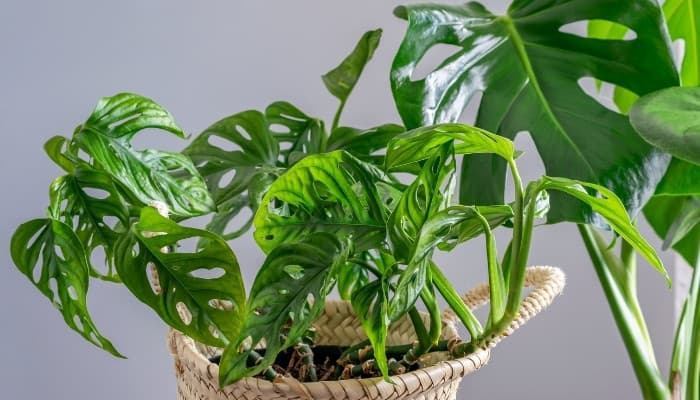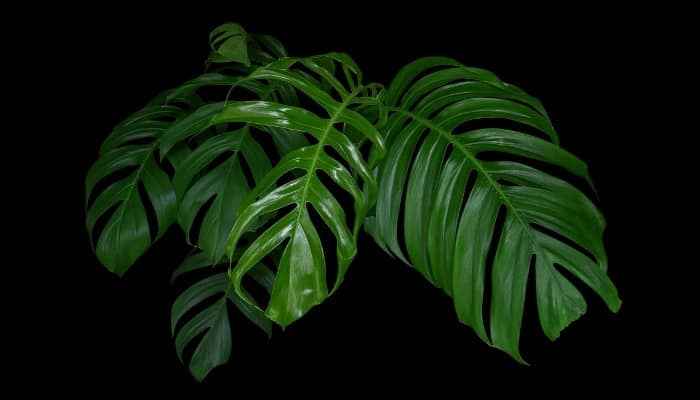If you encounter any problems while attempting to rephrase this text, please reply with this error message: Unable to process the request due to encountered difficulties. Monstera is a type of common indoor plant that is famous for the fenestrations, or holes, that appear in its leaves.
Typically, juvenile leaves will be intact, and the fenestrations will form as the leaves grow.
These plants have become very popular recently, leading to high price points for some varieties.
Are Monstera plants easy to grow? Monstera plants are quite easy to care for. They require a light soil that drains well and bright, indirect light. Temperatures of 65-85℉ are ideal. Water only when the top few inches of soil are dry, and fertilize once per month in the spring and summer. Repot every two years.
This popular plant is not a cheap purchase, so it is important to know how to keep your beautiful plant alive.
This article will provide all the information you need to grow a healthy Monstera.
Monstera Plant Care – Basic Needs
Monstera plants have the same basic requirements as most houseplants, which makes them easy to care for.
Best Soil for Monstera Plants
Monstera plants like moisture, but they do not like sitting in water. Therefore, a well-draining soil mixture is important.
Choose a mix that includes perlite or pumice, which will help with drainage and increase aeration for the roots.
Ideal Growing Conditions for Monstera
Monstera plants do best in bright or medium indirect light.
While some varieties can be trained to tolerate some direct sunlight, it is best to avoid direct, harsh sunlight (especially afternoon sun).
As tropical plants, Monstera plants will do well when kept between 65-85℉. Try not to allow the plant to drop below 60℉ and avoid any drafts or heaters near the plant.
Monstera plants love humidity! However, many plants do okay with average home humidity.
If you would like to increase the ambient humidity for your Monstera, mist the leaves occasionally or run a humidifier (my plants and I love this super-quiet model).
Watering Guide for Monstera
You should always check your soil before watering your Monstera. Stick your finger in the soil to feel how much moisture is in the soil.
The top 2-3 inches of soil should be completely dry before you water your Monstera. This is usually necessary every 1-2 weeks, depending on the conditions.
If the leaves on the Monstera plant are beginning to droop, you have gone too long between waterings.
Monstera plants benefit from filtered water, especially if you live in an area with hard water or high levels of chlorine.
Fertilizing Monstera Plants
Even though Monstera plants can be fast growers, they are not heavy feeders.
Use a balanced houseplant fertilizer once per month during the growing season (spring and summer for most locations). This organic liquid fertilizer is terrific for Monstera.
Do not fertilize in the winter when the plant stops growing.
Repotting
Typically, you will need to repot your Monstera every 2 years. If you see roots wrapping around the pot or growing out of the drainage holes, you may need to repot even sooner.
When you repot, only move up one pot size at a time.
If you use too large of a container, the excess soil will hold more moisture than the plant can use in a reasonable amount of time.
That excess moisture can cause infections, like root rot, to harm the plant.
As your Monstera plant gets larger, it will benefit from a moss pole (find them here at a great price) or other support structure to climb on.
Popular Monstera Varieties To Try

Monstera deliciosa is the most commonly seen Monstera plant and many people refer to it simply as a “monstera.” The fenestrations open to the edge of the leaf.
Monstera adansonii, also known as the swiss cheese plant, is another popular variety. It has fenestrations that stay in the center of the leaf and a smaller size than M. deliciosa.
Monstera siltepecana looks more like a Philodendron plant when it is young. The leaves are intact to start off and the fenestrations form once the plant is mature.
This plant also has a lovely silver sheen on the leaves.
Monstera dubia, also known as the shingle plant, gets its common name because it’s leaves grow flat against a surface.
Many people use a flat board as a support structure to show off the unique leaves.
If a rare and unusual Monstera is what you’re looking for, check out the Monstera obliqua.
How To Avoid Common Monstera Problems
The most common problem for Monstera plants is overwatering or underwatering. The best way to avoid this is to always check the soil before watering.
The top 2-3 inches of soil should be dry when you water your Monstera.
In addition to watering, insufficient lighting can also cause problems for Monstera plants. Yellowing leaves or very small leaves are a sign that your plant needs more sunlight.
Related Questions:
Can Monstera Grow Under LED Light?
Monstera plants do well when housed under LED grow lights.
This is a good option for locations where plants don’t receive enough light in winter or homes that do not have a lot of bright windows.
Why Is Monster So Popular?
The combination of unique, beautiful leaves and being easy to care for has made Monstera plants very popular.
Their popularity seems to be slightly waning, but that is actually helping to make more Monstera plants available at garden centers and nurseries.
Conclusion
Monstera plants can look intimidating with their large, flashy leaves, but now you have all the information you need to grow a healthy plant.
These easy-to-care-for plants are a great addition to any houseplant collection.

